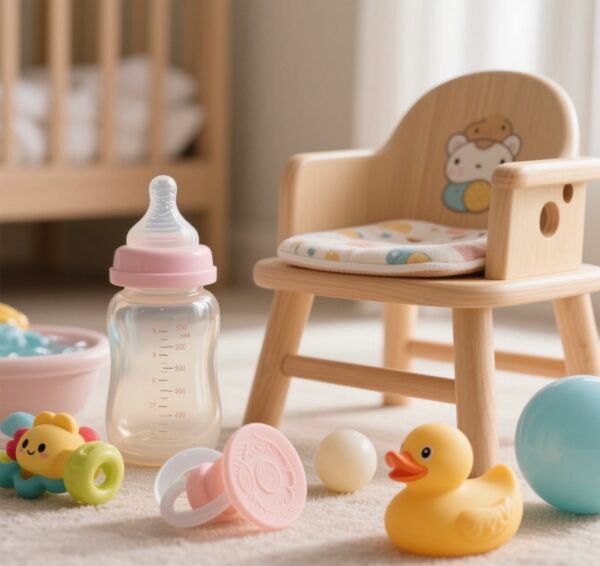Introduction
In today’s health-conscious society, parents seek products that offer not just comfort and functionality but also uncompromising hygiene for their babies. Feeding bottles, pacifiers, teethers, bath toys, mats, and furniture are in constant contact with infants’ mouths, skin, and hands, exposing them to microbial risks that their developing immune systems are not fully equipped to handle.
While traditional cleaning methods remain essential, integrating antimicrobial agents into the materials of baby products delivers passive, continuous protection that cleaning alone cannot guarantee. This innovation transforms how manufacturers approach safety and empowers parents with greater peace of mind.
Why Babies Are More Susceptible to Microbes
- Immature Immune System
Newborns and infants have underdeveloped immune defenses, making them more vulnerable to infections from bacteria, viruses, and fungi found in everyday environments. - High-Frequency Contact
Babies frequently place items into their mouths, transfer microbes from hands to face, and spend prolonged time in c - Moisture-Rich Environments
Teethers, pacifiers, and bath toys retain moisture,
Common Microbial Risks in Baby Products
| Product Type | Typical Microbial Threats |
|---|---|
| Feeding bottles & nipples | E. coli, Salmonella, Staphylococcus aureus |
| Teethers & pacifiers | Fungal growth (Candida spp.) from saliva moisture |
| Bath toys | Mold formation inside hollow toys |
| Play mats | Bacterial and fungal contamination from floors |
| High chairs & utensils | Residual food-borne bacteria |
How Antimicrobial Agents Provide Protection
Antimicrobial agents work by inhibiting the growth and reproduction of microorganisms on treated surfaces, reducing microbial load between cleanings. In baby products, this adds an essential layer of protection without replacing hygiene practices.
Silver-Based Agents
- Mechanism: Silver ions bind to bacterial cell membranes and enzymes, disrupting critical cellular functions and DNA replication.
- Applications: Silicone nipples, plastic feeding utensils, pacifiers.
- Advantages: Highly effective at low concentrations, minimal impact on material clarity or softness, and widely approved for food-contact applications under stringent mi
Zinc-Based Agents
- Mechanism: Interferes with microbial enzyme systems, inhibiting growth and metabolism.
- Applications: EVA foam play mats, PVC bath toys, baby furniture coatings.
- Advantages: Broad-spectrum efficacy, mild and safe for skin contact, cost-effective for large surface applications.
Copper-Based Agents
- Mechanism: Generates reactive oxygen species, damaging proteins and genetic material within microbes.
- Applications: Less common for direct contact products due to allergenicity concerns, but explored for hardware components in cribs or strollers.
- Advantages: Strong antifungal properties, durable integration into metal alloys.
Safety Standards and Regulatory Requirements
Because of direct infant contact, antimicrobial agents used in baby products must comply with the most stringent safety standards worldwide, including:
- FDA (USA): Food-contact notifications for antimicrobials used in feeding products.
- EU Regulations (REACH, EFSA): Migration limits and risk asses
- ISO 22196 / JIS Z 2801: Antibacterial performance testing standards.
- ISO 10993-10: Skin sensitization and irritation testing for prolonged skin contact materials.
Integration Into Baby Product Manufacturing
- Masterbatch Compounding
Silver or zinc-based antimicrobial agents are compounded into polymer masterbatches for silicone, polypropylene, PVC, and EVA foam to ensure uniform dispersion throughout the material.
- Coating Applications
For certain products, such as foam mats or bath toys, antimicrobial coatings provide surface protection. However, embedded solutions offer greater durability and resistance to wear and washing.
- Quality Control
Manufacturers conduct rigorous testing, including:
- Antimicrobial efficacy verification
- Migration testing to ensure safety limits are not exceeded
- Mechanical and durability assessments to maintain product performance
Market Trends: What Parents Want
Recent surveys reveal:
- Over 80% of parents are willing to pay a premium for baby products with proven antimicrobial protection.
- Top concerns include bacterial infections leading to diarrhea, oral thrush from fungal contamination,
- Key purchasing drivers are transparent safety certifications, brand trust, and independent laboratory testing results.
Benefits Beyond Hygiene
✅ Extended Product Lifespan
Prevents microbial degradation, discoloration, and odors, maintaining product aesthetics and usability.
✅ Sustainability Alignment
Longer-lasting products reduce replacement frequency, aligning with eco-conscious parenting.
✅ Competitive Advantage
Brands offering antimicrobial-integrated products differentiate themselves in a saturated market by addressing health and safety concerns proactively.
Limitations and Considerations
💰 Cost Implications
Integrating antimicrobial agents can raise manufacturing costs by 8–15%, requiring strategic pricing and value communication.
🛠 Material Compatibility
Formulation must avoid negative interactions with other additives, pigments, o
📜 Regulatory Compliance
Strict adherence to local and international safety standards is non-negotiable, with clear labeling to avoid misleading claims.
Future Outlook
🔬 Natural-Origin Antimicrobials
Growing research into plant-based antimicrobial agents (e.g. chitosan, peptide-based systems) to complement inorganic options for “natural” product positioning.
🌱 Biodegradable Materials with Antimicrobial Properties
Combining hygiene protection with eco-friendly polymers to meet sustainability and safet
🧠 Smart Antimicrobial Technologies
Emerging solutions using triggered release systems that activate under specific conditions (e.g. moisture, temperature) for targeted protection.
Conclusion
Integrating antimicrobial agents into baby products is not merely a manufacturing innovation – it is an expression of responsibility towards infant health and wellbeing. As parents demand safer, more hygienic products, and regulations tighten worldwide, antimicrobial-integrated baby products stand at the intersection of science, trust, and market leadership.
✉️ Partner With Us
We specialize in silver, zinc, and copper-based antimicrobial formulations for baby product manufacturers, optimized for safety, efficacy, and global regulatory compliance. Contact us to co-create products that protect the next generation with confidence and care.


-300x210.jpg)
